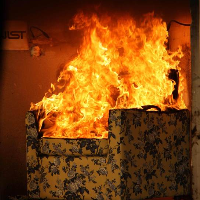Researchers Find Dangerous Flame Retardants Everywhere in Preschools and Childcare

In case anyone still wondered, decades of putting dangerous, unhealthy flame retardants in furniture and myriad other products has made them ubiquitous in preschools and childcare settings despite some efforts in recent years to scale it back.
Researchers at the University of California, Berkeley, found that floor dust samples in 100% of the 40 early-childhood education centers tested positive for 14 different PBDEs, or polybrominated diphenyl ethers, and four non-PBDE flame retardants, including tris phosphate compounds. It was also found at lower levels in the centers' air where more than 1,760 kids attended in Alameda and Monterey counties.
None of these chemicals are good. They have been linked to hormone disruption and lowered IQs in children. Around 90% of children’s furniture contains the chemicals, according to a study (pdf) by the Center for Environmental Health.
Some have been banned and some have been discouraged. One golden oldie, tris, was thought by the study's lead author to have been abandoned by manufacturers a long time ago.
“I remember learning about the tris phosphate flame retardants in kids’ pajamas when I was in high school 35 years ago, so it’s a bit surprising to still be seeing them today,” Asa Bradman reminisced in a UC Berkeley press release. “They were never banned. There seems to have been a resurgence in recent years as manufacturers looked for PBDE replacements.”
They lost some of their popularity in the 1970s when research at Berkeley showed tris was a mutagen and presumed to be a carcinogen.
Manufacturers have been hunting around for new old chemicals because some of the old new chemicals have been getting bad press and undergoing government scrutiny. California banned two of the PBDEs in 2006. Late last year, California dumped the standard for flame retardants in furniture it had championed in 1975 because it encouraged their use instead of more effective and less toxic fabric treatments.
It did not ban the retardants; it just made it easier for companies to meet flammability standards without harming people. “The previous standards focused predominantly on filling materials, where fires don’t actually start,” said Tonya Blood, chief of the Bureau of Electronic and Appliance Repair, Home Furnishings and Thermal Insulation. “The new standards were developed to address where the fire begins, which is the cover fabric, and to focus on the interactions of the cover fabric and filling materials.”
Good idea.
Twenty-nine of the tested facilities had upholstered furniture that contained foam, which tested considerably higher in concentration for flame retardant chemicals. Seventeen had napping equipment with the same stuff.
Researchers were not surprised to find the chemicals and, in fact, found the median level of concentrations to be slightly lower than other studies of homes have found—except for the chlorinated tris. Those median levels were equal to or higher than household levels.
–Ken Broder
To Learn More:
Study Finds Hazardous Flame Retardants in Preschool, Childcare Settings (by Sarah Yang, UC Berkeley News Center)
Hazardous Flame Retardants Ubiquitous In Preschools (by Victoria Colliver, San Francisco Chronicle)
State Repeals Standard for Toxic Furniture Flame Retardants It Once Championed Nationally (by Ken Broder, AllGov California)
Flame Retardant Exposures in California Early Childhood Education Environments (University of California, Berkeley researchers, Chemosphere)
- Top Stories
- Controversies
- Where is the Money Going?
- California and the Nation
- Appointments and Resignations
- Unusual News
- Latest News
- California Forbids U.S. Immigration Agents from Pretending to be Police
- California Lawmakers Urged to Strip “Self-Dealing” Tax Board of Its Duties
- Big Oil’s Grip on California
- Santa Cruz Police See Homeland Security Betrayal in Use of Gang Roundup as Cover for Immigration Raid
- Oil Companies Face Deadline to Stop Polluting California Groundwater





